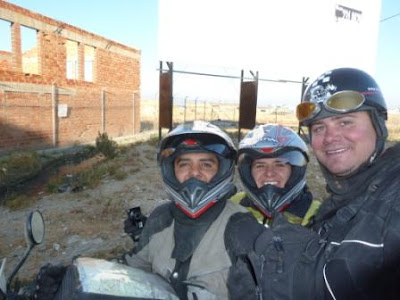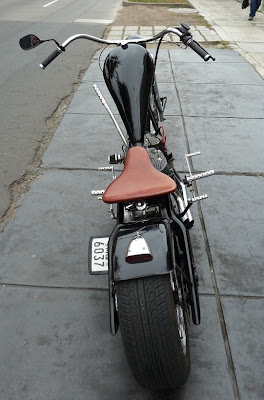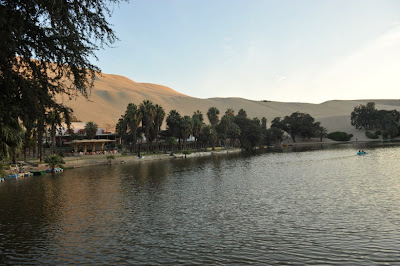Bolivia
Upon arrival in La Paz it was already dark, despite some of the easiest customs so far on the trip. The Bolivians officers are obviously more interested in a good conversation none of the involved understands. I still don’t speak Spanish, and they still don’t understand English. I think we made great friends.
La Paz is fairly big, and systematic as a trash dump site. As most dump sites, it’s located in a steep slope, and I arrive on the top. Obviously center of town with the hostels has to be down, so I go down, but unfortunately too far. At the bottom I realize I had taken too much advantage of the gravity, and start to work my way up again.
Easier said than done, at 3600 meters above sea level there isn’t much left of the bottomless pit of torque and 22 horsepower. The hills are steep and I get quite a bit up before it’s a lost case.
I take off the air cleaner so the beast can breathe a bit more, and plan the junctions so I don’t have to stop. After a lot of attempts and zigzagging different roads I’m in the center again. To go down took me a half hour; to go back up took me two hours.
First and third gear starts to go on strike on the way up, and get noticeably worse the last hour. They’ve caught up the Bolivian culture, and the bike is more concerned about blocking the roads than getting me to bed that night. I do make it anyway, and get to bed mighty tired.
Well rested the next morning I’m trying to find a place with WIFI and breakfast, in vain. I get met by the Peruvian and Bolivian battle cry, “No hay”* everywhere. Further, the thought of the soon to die totally gearbox makes me further frustrated.
La Paz is fairly big, and systematic as a trash dump site. As most dump sites, it’s located in a steep slope, and I arrive on the top. Obviously center of town with the hostels has to be down, so I go down, but unfortunately too far. At the bottom I realize I had taken too much advantage of the gravity, and start to work my way up again.
Easier said than done, at 3600 meters above sea level there isn’t much left of the bottomless pit of torque and 22 horsepower. The hills are steep and I get quite a bit up before it’s a lost case.
I take off the air cleaner so the beast can breathe a bit more, and plan the junctions so I don’t have to stop. After a lot of attempts and zigzagging different roads I’m in the center again. To go down took me a half hour; to go back up took me two hours.
First and third gear starts to go on strike on the way up, and get noticeably worse the last hour. They’ve caught up the Bolivian culture, and the bike is more concerned about blocking the roads than getting me to bed that night. I do make it anyway, and get to bed mighty tired.
Well rested the next morning I’m trying to find a place with WIFI and breakfast, in vain. I get met by the Peruvian and Bolivian battle cry, “No hay”* everywhere. Further, the thought of the soon to die totally gearbox makes me further frustrated.
The plan is to do the Yungas Road, the next day. The so called death road goes down to Coroico, and involves a 3500 meter climb up to 4700 meters on the way back, not feasible without the first gear.
The frustration goes over to irritation. It seems to be no justice in the world, driving half way around the world and have to skip the Yungas does not make sense. If the gearbox had broken two days later it would have been ok.
Frustration goes over to idiocy. I decide to do the Yungas anyway. I will always get down, and to worry about the ascend is to take problems in advance.
Luck is on my side as always, next day my old friends Carlos and Elenize appear in town with their Honda Africa Twin. Carlos sends off Elenize on a bicycle down the death road, while he joins me. At least I’m not alone when the trouble sooner than later will show up.
The way down goes well, despite not being able to brake on first with the engine. The Nimbus brakes were designed in the thirties when the road was built so it matches well. The road proves fairly boring and not deadly at all so it’s quite a disappointment, though scenic.
At the bottom the first gear is completely picked up by the oh mighty Father in the gearbox heaven, I can’t even start the bike on first though I stand on the shifter. It’s the second that rules from now on.
It works ok up to 3500 meters. Then I have to take off the air cleaner again, and that takes me up to about 3800 meters. From there on it’s “No hay”, the bike didn’t say it, but if it could I knew it would.
Rescue is at bay and is called Carlos and Africa Twin, we got a strap and he’s got the power in his Honda. He hauls me to the top, and back to La Paz it’s only downhill. I made it both up and down the Death Road, thanks to Carlos, just a pity it’ll be “No hay” first and third gear the next 3000 kilometers to Brazil.
*No hay is the indigenous national slogan for Peru and Bolivia, and means something like “There isn’t”. No matter what you ask for the reply will normally be “No hay”, and the higher altitude the more “No hay” there is. “No hay” is recorded in the literature at least as early as the 1970íes by Ted Simon when he tried to buy meet in Peru, but is probably phenomenon centuries old.
Tormod
Bolivia
Bolivia startet flott med den raskeste grenseovergangen så langt pa turen, vel å merke med unntak av i EU. Jeg burde skjønt at det var et dårlig tegn. Alt gikk for lett.
Ankomst I La Paz skjedde selvsagt etter det ble mørkt, og uten kart viste det seg enkelt å kjøre seg vill, til tross for at jeg ikke skulle noe spesielt sted I byen. Byen er bare tilfeldig kastet på plass i en bratt skråning, med en rekke flotte og bratte bakker. Dette straffer seg fort når en er på nesten 4000 meter over havet.
Resultatet var at jeg endte i bunnen, og kom ikke opp igjen. Siste utvei for å komme opp i sentrum igjen var å ta av luftfilteret, skru nåla til topps og løpe ved siden av sykkelen i de verste oppoverbakkene. Etter mye ralling kom jeg meg til sentrum igjen, og fant et dårlig hotell.
I strabasene hadde imidlertid både første- og tredjegiret begynnt å takke for seg, for fjerde gang på turen. Mine kalkulasjoner tilsa at dette skulle skje først I Afrika, så delen som er problemet hadde jeg lagt igjen Lima.
Fortvilelsen tok nesten overhand da dette egentlig satte en stopper for aa kjoere Yungas Road, den såkalte dødsveien som er utropt til verdens farligste vei. Fortvilelsen gikk over til irritasjon. Irritasjonen gikk over til idioti, så jeg bestemte meg for å kjøre den uansett. Ned kommer en alltids, og tenke på oppoverturen uten førstegir ville være å ta sorgene på forskudd.
Herren så som vanlig til sine, og min gamle Africa beTwinnede kamerat Carlos kom til byen og bestemte seg for å slå følge. Det var i grunnen ren skjær flaks, hvis ikke hadde jeg vært nedi der ennå.
Nedfarten gikk fint, jeg kunne ikke motorbremse på førstegir, men bremsene på Nimbusen var designet på tredvetallet, da veien ble bygd, og matchet derfor perfekt. Turen var fin den, men veien var en skuffelse. Det var lite trafikk og ikke spesielt smalt. Terasseveien i Pakistan er langt verre, så det hele fremsto i grunnen som en turistbløff.
Det gikk fra 4700 meter på det høyeste og ned til 1200. Vel fremme i bunnen var førstegiret fullstendig hentet hjem til Far, slik at jeg må ta i gang på andre gir. For ikke å dra strikken for langt bestemte vi oss derfor å kjøre den nye veien opp igjen, noe som viste seg lurt.
Da jeg kom opp til 3700 meter nyttet det ikke en gang å ta av luftfilteret lenger. Det var bom stopp, men Carlos skjønte noe var galt og kom tilbake etter meg. Vi satte I gang en av de større Nimbus-taueoperasjonene som noen sinne har blitt utført I Andesfjellene. Etter en times tid var vi på toppen, og kunne ta Nimbusen av kroken og trille pent ned igjen til La Paz, og alle var enige om at det hadde vært en fin tur.
Tormod
 First known picture of Nimbus beside Lake Titicaca, the world’s highest located lake
First known picture of Nimbus beside Lake Titicaca, the world’s highest located lake This is the ferry across one of the straights at Lake Titicaca. At least it was cheap.
This is the ferry across one of the straights at Lake Titicaca. At least it was cheap. I was somewhat skeptic, but if it was ok for a big lorry it should be ok for a bike too.
I was somewhat skeptic, but if it was ok for a big lorry it should be ok for a bike too. Shop with a lots of nice things Bolivians need, for instance dried llama fetus´
Shop with a lots of nice things Bolivians need, for instance dried llama fetus´ Lama fetus is said to bring good luck, and is obligatory to dig down under houses when being built. I wanted to try it on my transmission, but the odor made me re-evaluate the plan.
Lama fetus is said to bring good luck, and is obligatory to dig down under houses when being built. I wanted to try it on my transmission, but the odor made me re-evaluate the plan. Indians stick to traditional food like pizza.
Indians stick to traditional food like pizza. Centro La Paz
Centro La Paz The San Francisco Plaza, La Paz
The San Francisco Plaza, La Paz To Coroico it’s 76 kilometers, and almost 3500 meters down
To Coroico it’s 76 kilometers, and almost 3500 meters down

 There are still some Lorries and buses on the old road, but far from enough to make it interesting.
There are still some Lorries and buses on the old road, but far from enough to make it interesting.






 I got to this point, but not any further. A properly working gearbox in not overestimated in the Andes.
I got to this point, but not any further. A properly working gearbox in not overestimated in the Andes. Carlos is the hero of the day, and towed me with his white Honda horse to the top.
Carlos is the hero of the day, and towed me with his white Honda horse to the top.
 “Pedersen Lastebil” is probably missing their truck. This truck used to run close to my hometown and was either stolen or sold to Bolivia. A quarter of the trucks here is coming from Scandinavia and still has the stickers from the first owners.
“Pedersen Lastebil” is probably missing their truck. This truck used to run close to my hometown and was either stolen or sold to Bolivia. A quarter of the trucks here is coming from Scandinavia and still has the stickers from the first owners. Sties Termotransport used to be the biggest logistics company in Norway for termo cargo. They obviously flagged out and moved to Bolivia.
Sties Termotransport used to be the biggest logistics company in Norway for termo cargo. They obviously flagged out and moved to Bolivia. Bolivias sister town of Raufoss, Norway. Raufoss is in Norway famous for being the asshole of the world, and is pretty much like this town, plus a roundabout and a light junction.
Bolivias sister town of Raufoss, Norway. Raufoss is in Norway famous for being the asshole of the world, and is pretty much like this town, plus a roundabout and a light junction.

 My good friends Carlos and Elenize
My good friends Carlos and Elenize










































